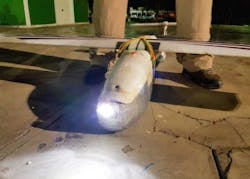Drone delivers antivenom and blood samples in Amazon rainforest
As part of a recent field test, WeRobotics—an organization that utilizes aerial robots for humanitarian and environmentalprojects—recently deployed a mapping drone to drop off antivenom and return blood samples from nearly 25 miles into the Amazon jungle.
Many sparsely-populated communities within the Amazon rarely have access to essential medicines and public health services. Local doctors in the region of Contamana, Peru report an average of 45 snakebites per month, with no rapid access to antivenom. Because of this, WeRobotics traveled to the area to learn more about these challenges, and explore whether cargo drones could be used to overcome the problems in a sustainable manner, according to the company.
WeRobotics’s original plan, referred to as Plan A, involved the deployment of a $30,000 drone made by a North American company into the Amazon rainforest in Peru for purposes of dropping off antivenom, and returning blood samples. Despite having previously reported successful flights elsewhere in the world, the company was unable to complete the task due to technical difficulties, and Plan A was called off and the company left Peru on December 19. Before this plan had failed, however, Juan Bergelund, Coordinator of Peru Flying Labs, had already proposed a backup plan using a small fixed-wing mapping drone he had with him.
The drone, an E384 from Event 38, costs just under $3,000. Weighing just 5.6 lbs., the E384 can reportedly fly for up to 44 miles and map up to 1,000 geo-referenced acres per flight at 5 cm / pixel resolution. The drone, however, can only carry a payload of up to 2.2 lbs, so in order to be able to carry the antivenom into the jungle, Bergelund removed the drone’s camera and put the antivenom in its place. Hand launched and programmed to fly autonomously to the drop point, the drone was nicknamed “Franky” after Frankenstein, because of how many repairs it had gone through.
Despite this, the repurposed drone was hand launched from a field in Contamana after a chilled antivemom medicine bottle was put into a cold pack and placed within the drone, with the idea that it would be able to travel nearly 25 miles into the jungle to deliver the medicine. The landing, according to WeRobotics, was smooth, as many villagers came out to witness the first ever cargo delivery flight in the Amazon rainforest. The drone’s battery was at 40% when it landed in Pampa Hermosa, suggesting that it could have flown even further.
In Pampa Hermosa, the medicine was removed from the cold pack and given to a doctor, who simulated a snakebite response, with a young boy in the village acting like he had been bitten. This was accomplished within 10 minutes of the drone being landed in the field. After the boy was “saved,” the team programmed the drone to fly back at night, and automatically land in the same field, as opposed to the manual landing that was done when the medicine arrived. This time, the cargo was a blood sample taken from WeRobotics, with the simulation being done so a doctor in Contamana could test the blood for diagnostic purposes and call the doctor in Pampa Hermosa with the results to make the right choices for intervention and medication. To fly at night, the drone had a bike light taped to its nose.
Following the test, the team concluded that if a drone was on standby in Contamana, it could be used to fly antivenom to Pampa Hermosa and the patient could be treated within approximately 45 minutes, compared to the 3-6 hours that a riverboat would take.
“Thanks to the success of our first drone deliveries, we’ve been invited back by the Ministry of Health and local doctors to carry out additional field tests,” said Patrick Meier of WeRobotics in a blog post. “This explains why our Peru Flying Labs team is back in the Amazon this very week to carry out additional drone deliveries.”
He continued, “We’re also gearing up to carry out deliveries across a distance of more than 100km using affordable drones. In parallel, we’re also working on this innovative Zika-control project with our Peru Flying Labs; drawing on lessons learned from our work in the Amazon Rainforest.”
View more information on the field testing.
View more information on WeRobotics.
Share your vision-related news by contacting James Carroll, Senior Web Editor, Vision Systems Design
To receive news like this in your inbox, click here.
Join our LinkedIn group | Like us on Facebook | Follow us on Twitter
Learn more: search the Vision Systems Design Buyer's Guide for companies, new products, press releases, and videos
About the Author

James Carroll
Former VSD Editor James Carroll joined the team 2013. Carroll covered machine vision and imaging from numerous angles, including application stories, industry news, market updates, and new products. In addition to writing and editing articles, Carroll managed the Innovators Awards program and webcasts.
